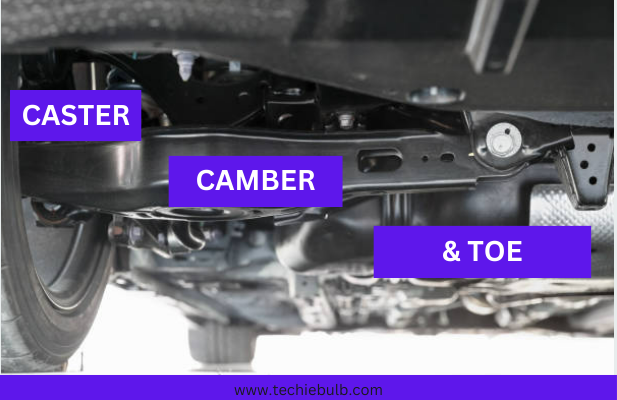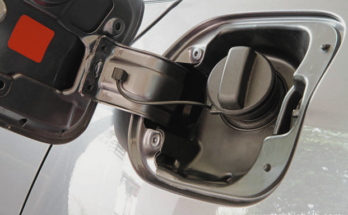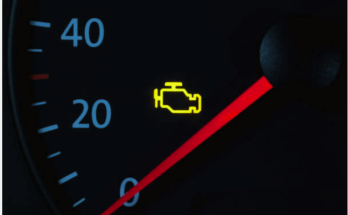Caster, camber, and toe are critical components of a vehicle’s alignment, each playing a crucial role in ensuring optimal driving performance and safety. Caster angle influences steering stability and returnability, enhancing control and maneuverability, particularly at higher speeds, by ensuring that the vehicle tracks straight and responds predictably to steering inputs. Camber angle determines the tilt of the wheels concerning the vertical axis, crucial for maintaining even tire wear and maximizing tire contact with the road surface during cornering, thereby improving traction and stability. The toe angle dictates the direction in which the wheels point relative to each other, promoting straight-line stability and preventing excessive tire wear by ensuring predictable steering response and straight tracking.
Regular alignment checks and adjustments are necessary to maintain the correct alignment of the caster, camber, and toe, thereby optimizing vehicle performance, prolonging tire life, and ensuring safe driving experiences on the road.
Important Points to Remember:-
- Caster Angle: Steering Stability and Returnability
- Camber Angle: Tire Wear and Grip
- Toe Angle: Steering Response and Tire Wear
What is Caster?
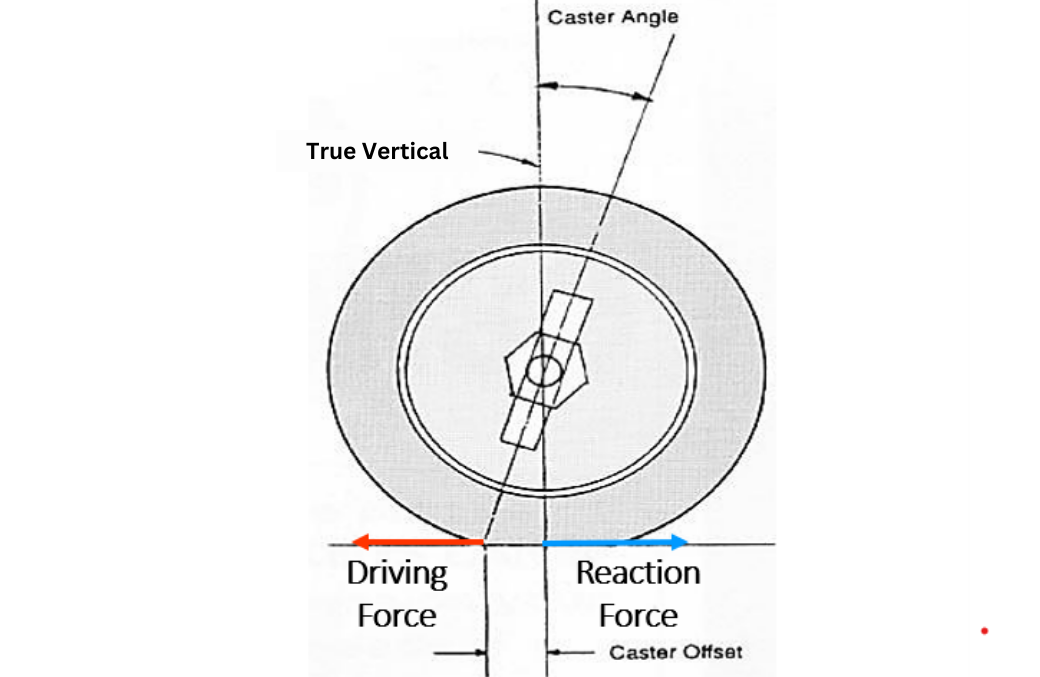
Caster refers to the angle of the steering axis when viewed from the side of the vehicle. It plays a crucial role in steering stability and returnability. Essentially, a caster determines how easily your vehicle returns to its straight-ahead position after making a turn. A higher caster angle enhances steering stability, making the vehicle feel more planted and responsive on the road.
On the contrary, a lower caster angle may result in a lighter steering feel but could compromise stability, especially at higher speeds. The caster angle value typically ranges between 2 to 5 degrees for most of the vehicles.
Types of Caster Angles
- Positive Caster: Positive caster occurs when the steering axis is inclined towards the rear of the vehicle. In this configuration, the top of the steering axis is positioned behind the bottom, creating an angle that slopes towards the rear. Positive caster enhances steering stability and self-centering properties, promoting straight-line tracking and improving high-speed stability. It also aids in returning the steering wheel to the center position after completing a turn, enhancing driving comfort and reducing driver fatigue.
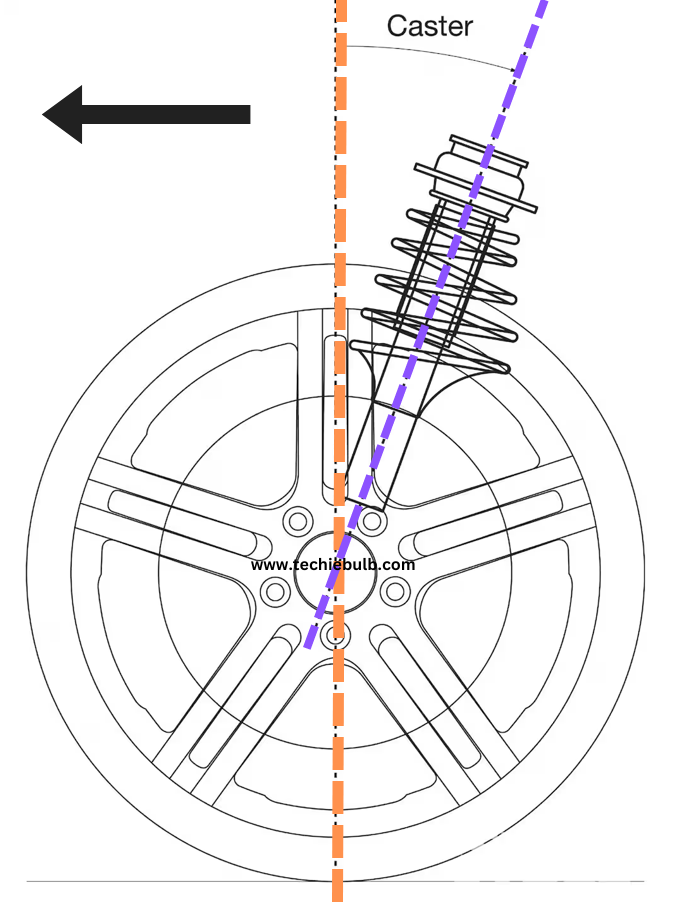
- Negative Caster: A negative caster is the opposite of a positive caster, where the steering axis is inclined towards the front of the vehicle. This means that the top of the steering axis is positioned in front of the bottom, creating an angle that slopes towards the front. Negative caster is less common in modern vehicles but may be utilized in certain applications to achieve specific handling characteristics. Negative caster can result in reduced steering stability and self-centering properties, making the vehicle feel less stable at high speeds and less responsive to steering inputs.
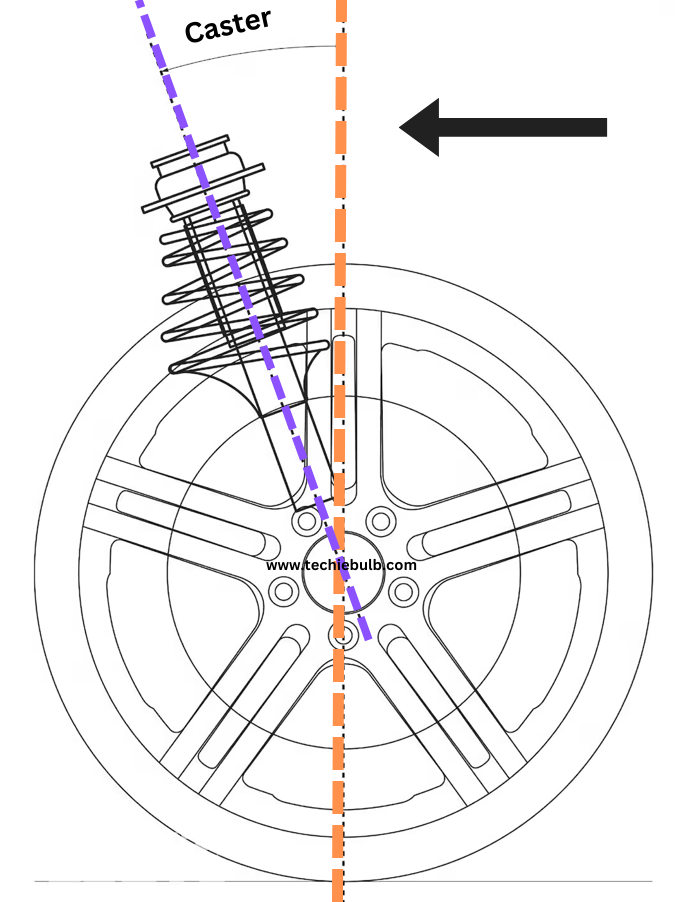
- Zero Caster: Zero caster refers to a configuration where the steering axis is vertical, with no inclination towards the front or rear of the vehicle. In this setup, the top of the steering axis aligns directly above the bottom, resulting in no caster angle. Zero caster is rare in automotive applications and is typically not used in production vehicles. However, it may be encountered in specialized applications where specific handling characteristics are desired.
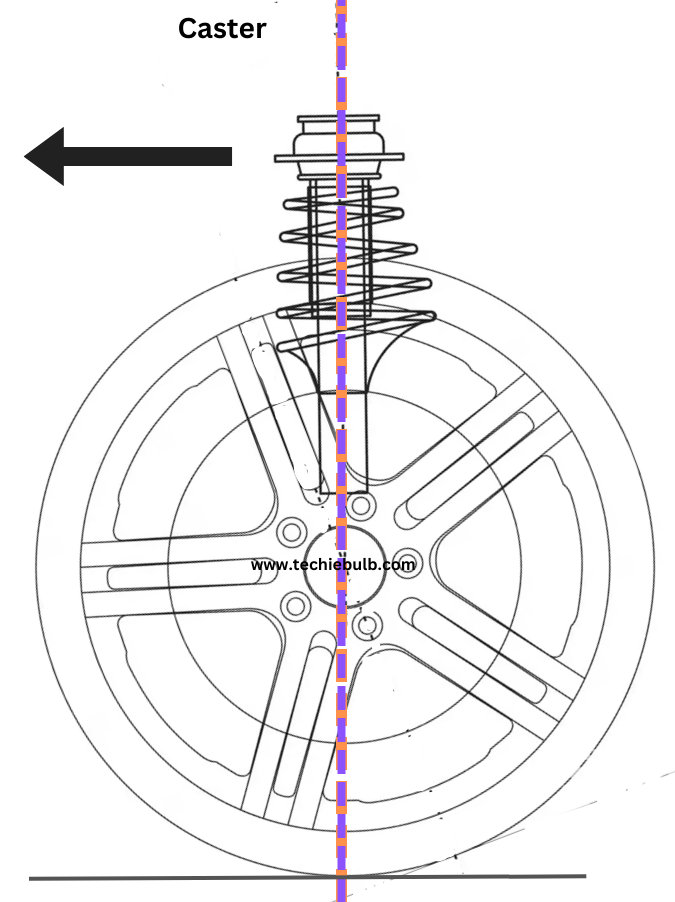
How does caster affect driving?
Caster angle significantly influences driving by affecting steering stability and returnability. When the caster angle is correctly set, it enhances control and maneuverability, particularly at higher speeds. A positive caster angle contributes to the vehicle’s ability to self-center after making turns, ensuring that the vehicle tracks straight and responds predictably to steering inputs. This self-centering effect provides a smoother driving experience and reduces the need for constant steering corrections, especially on long journeys or highways.
Additionally, a higher caster angle enhances straight-line stability, making the vehicle feel more planted on the road and less susceptible to wandering or drifting. In summary, the caster angle plays a crucial role in maintaining steering stability, improving control, and enhancing overall driving comfort and safety.
What is Camber?
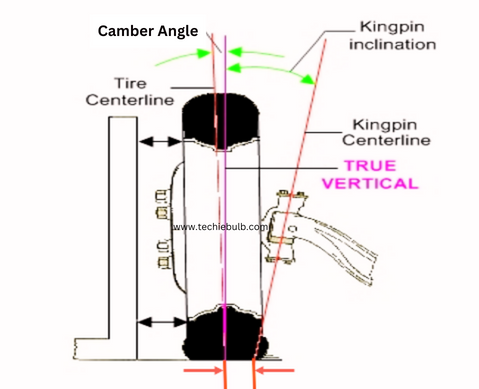
Camber angle refers to the tilt of the wheels concerning the vertical axis when viewed from the front or rear of the vehicle. Positive camber means the tops of the wheels tilt away from the vehicle, while negative camber means they tilt towards it. Proper camber alignment is essential for maintaining even tire wear and maximizing tire contact with the road surface during cornering. The camber angle value typically ranges from -1 to +1 degrees for most of the vehicles. However, this can vary depending on the vehicle’s make, model, and suspension design.
Types of Camber Angles
- Positive Camber: Positive camber occurs when the tops of the wheels tilt away from the vehicle’s centerline. This type of camber is commonly seen in vehicles where the tops of the wheels are positioned further apart than the bottoms. Positive camber helps improve stability, particularly during cornering, as it increases the contact patch of the tire when the vehicle leans inwards.
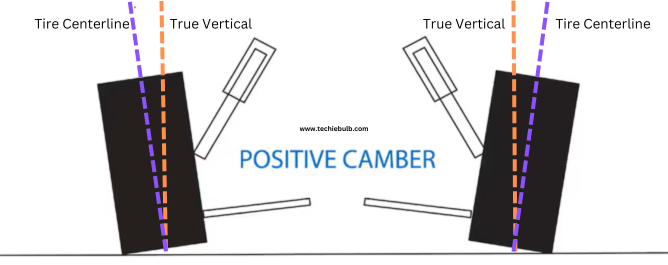
- Negative Camber: Negative camber is the opposite of positive camber, where the tops of the wheels tilt towards the vehicle’s centerline. This type of camber is often employed in performance-oriented vehicles or racing cars. Negative camber enhances cornering grip by keeping more of the tire tread in contact with the road during aggressive maneuvers. However, excessive negative camber can lead to uneven tire wear on the inner edges of the tires.
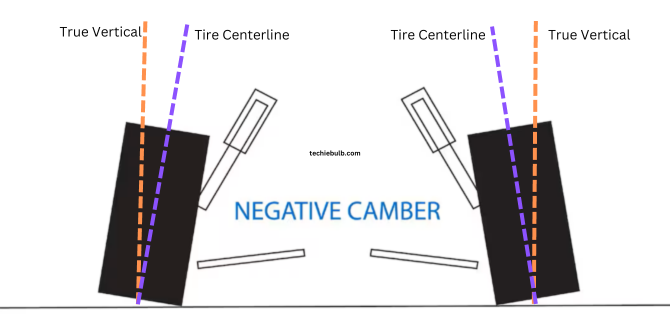
- Zero Camber: Zero camber occurs when the tops of the wheels are perfectly vertical and parallel to the vehicle’s centreline. In this configuration, the tire’s contact patch is evenly distributed across the tread width. Zero camber is commonly used in passenger vehicles for balanced tire wear and stable handling characteristics during straight-line driving.
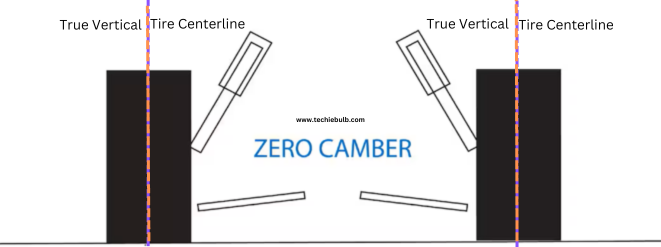
How does Camber affect driving?
When the camber angle is correctly adjusted, it ensures an equitable distribution of tire contact with the road surface. This optimized contact enhances the tire’s grip during cornering and maneuvering, thereby promoting improved traction and stability.
Positive camber, characterized by the outward tilt of the wheels’ tops, can bolster cornering grip and stability, particularly in high-speed driving scenarios. However, excessive positive camber may lead to uneven tire wear along the outer edges, compromising overall tire longevity and potentially diminishing grip during straight-line driving.
On the other side, a negative camber, featuring an inward tilt of the wheels’ tops, can enhance straight-line stability and mitigate the vehicle’s tendency to roll during cornering. Nevertheless, an overabundance of negative camber might result in uneven tire wear along the inner edges, impacting overall traction and handling.
What is Toe?
The toe angle determines whether the wheels point towards each other (toe-in) or away from each other (toe-out) when viewed from above. Incorrect toe alignment can result in excessive tire wear and affect steering response. Too much toe-in can cause the vehicle to feel sluggish and unstable, while too much toe-out can lead to instability and wandering on the road. Proper toe alignment ensures that the wheels are aligned parallel to each other, promoting straight-line stability and predictable steering response. The value of toe is typically measured in millimeters (mm) rather than degrees. The acceptable range for toe in the vehicles is between 2 mm to 5 mm.
Types of Toe Angles
- Toe-In Toe-in occurs when the front edges of the wheels are closer together than the rear edges. In other words, the wheels are angled slightly inward towards the vehicle’s centerline. Toe-in is commonly used in vehicle alignments to improve straight-line stability and reduce tire wear. It helps counteract the tendency of the wheels to splay outward during forward motion, promoting a straighter trajectory and enhancing handling stability.
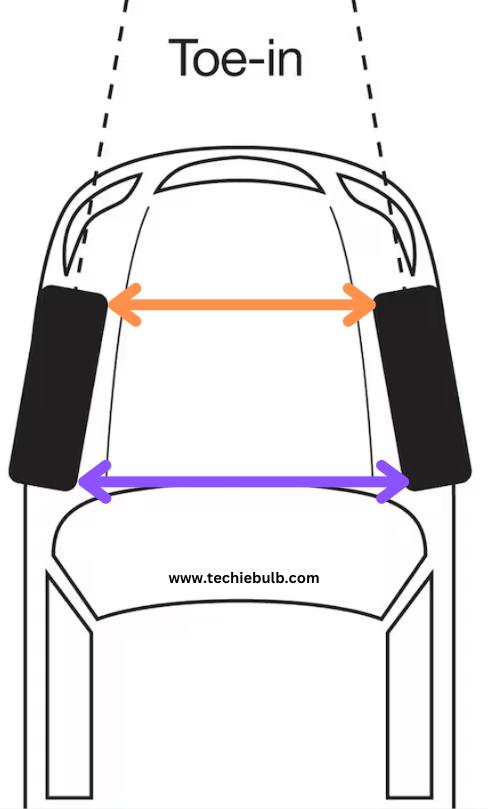
- Toe-Out: Toe-out is the opposite of toe-in, where the front edges of the wheels are positioned further apart than the rear edges. This configuration angles the wheels slightly outward from the vehicle’s centreline. Toe-out is less common in vehicle alignments and is typically used in specific applications to achieve desired handling characteristics. It can improve cornering agility and responsiveness by promoting sharper turn-in and reducing understeer tendencies. However, excessive toe-out can lead to increased tire wear and instability, particularly during straight-line driving.

- Zero Toe: Zero toe refers to a configuration where the front edges of the wheels are parallel to each other and perpendicular to the vehicle’s centreline. In this setup, there is no angle between the wheels, resulting in zero toe angle. Zero toe is often used in vehicle alignments to achieve balanced tire wear and stable handling characteristics. It helps maintain a neutral steering feel and promotes consistent tire contact with the road surface during straight-line driving.
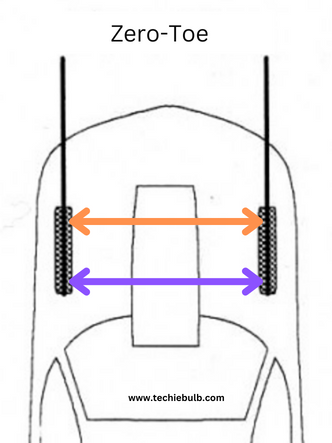
How does Toe affect driving?
Toe angle, although seemingly subtle, has a profound impact on driving dynamics. It refers to the direction in which the wheels point relative to each other when viewed from above. When the toe angle is correctly adjusted, it ensures that the wheels are aligned parallel to each other, promoting straight-line stability and predictable steering response.
Excessive toe-in, where the wheels point towards each other, can cause the vehicle to feel sluggish and unstable, particularly during high-speed driving. This configuration may result in increased tire wear, as the tires scrub against the road surface, leading to premature deterioration and reduced longevity.
Other hand, excessive toe-out, where the wheels point away from each other, can lead to instability and wandering on the road. The vehicle may feel twitchy and less controllable, especially during cornering and lane changes. Like toe-in, excessive toe-out can also accelerate tire wear and compromise driving safety.
Conclusion
In summary, caster, camber, and toe are fundamental aspects of wheel alignment that significantly influence a vehicle’s handling, stability, and tire wear characteristics. Proper alignment ensures that the tires make optimal contact with the road surface, maximizing traction and control in various driving conditions.
Regular wheel alignments are essential for maintaining vehicle safety, performance, and fuel efficiency. If you notice uneven tire wear, steering pull, or handling issues, it’s essential to have your vehicle’s alignment checked by a qualified technician. By understanding the basics of caster, camber, and toe, you can better appreciate the importance of wheel alignment in keeping your vehicle running smoothly on the road.
FAQ on Caster, Camber & Toe
-
How often should I check my vehicle’s alignment?
- It’s recommended to check your vehicle’s alignment every 6,000 to 10,000 miles or if you notice any signs of uneven tire wear or handling issues.
-
What are the signs of misaligned wheels?
- Signs of misalignment include steering pulling to one side, uneven tire wear patterns, vibrating steering wheel, or feeling unstable at high speeds.
-
Can alignment issues affect fuel efficiency?
- Yes, misaligned wheels can increase rolling resistance, leading to decreased fuel efficiency over time.
-
What causes misalignment in vehicles?
- Misalignment can be caused by various factors, including hitting potholes, curbs, or other road hazards, worn suspension components, or improper installation of suspension parts.
-
How can I tell if my vehicle’s alignment is off?
- Signs of misalignment include steering pulling to one side, uneven tire wear patterns, vibrating steering wheel, or feeling unstable at high speeds.

